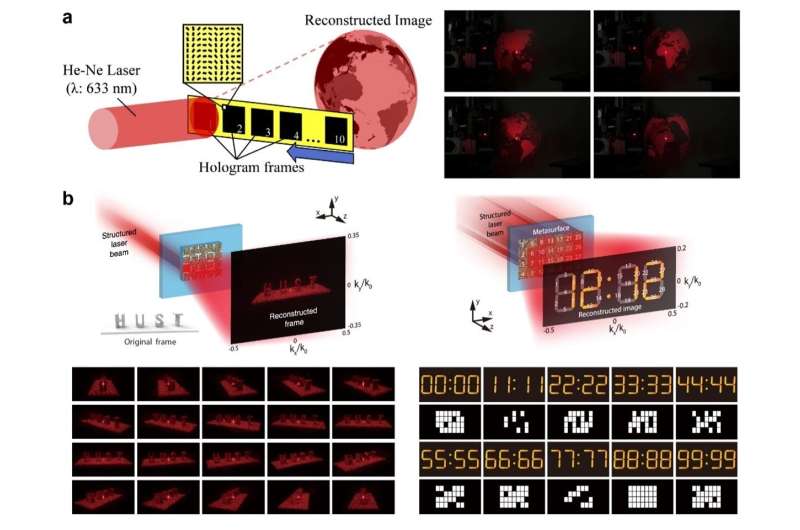Recent advances in optical dynamic meta-holography

In a new publication from Opto-Electronic Advances the research group of Professor Xiong Wei, from Huazhong University of Science and Technology, Wuhan, China, discuss recent advances in optical dynamic meta-holography.
In science fiction movies (e.g., Star Wars), naked-eye three-dimensional (3D) display scenes are so fantastic that they have attracted much attention to develop related technologies. Holography technology would provide a wonderful naked-eye display platform to greatly enhance visual immersion and reality, change the methods of human-computer interaction and human-human communication, and revolutionize our daily lives. Traditional optical holography requires a complicated shooting process to record the interference pattern of light beams from target objects and a reference path, and therefore cannot create a holographic reconstruction of a virtual object. Computer-generated holography overcomes this limitation and can also provide dynamic holographic display by using digital light field modulators, such as spatial light modulators (SLMs) and digital micromirror devices (DMDs). However, there are many shortcomings resulting from the large pixel sizes and limited modulation principle such as the small field of view (FOV), twin imaging, narrow bandwidth and multiple orders of diffraction.
In recent years, metasurfaces emerge to meet the requirement of hologram on complicated light field modulation capabilities. Metasurfaces possess more powerful light modulation abilities that provide much more degrees of freedom to design holograms than conventional CGH devices. In addition, meta-holography has several advantages such as a higher spatial resolution, lower noise, a larger working frequency bandwidth and elimination of undesired diffraction orders.
Meta-holography can be classified into the two categories of static meta-holography and dynamic meta-holography based on the number of optical images reconstructed from a single piece of a metasurface element. Dynamic meta-holography is more suitable for optical display and information processing applications than static meta-holography. For example, to achieve fantastic naked-eye 3D display scenes as shown in science fiction movies or to realize optical camouflage in military reconnaissance, dynamic display is a fundamental and essential capability.
The research groups of Prof. Wei Xiong from Huazhong University of Science and Technology and Prof. Minghui Hong from National University of Singapore focused on the topic of dynamic meta-holography to give a comprehensive review for introducing recent development. Based on the realization methods, dynamic meta-holography can be mainly divided into two categories: tunable metasurfaces and multiplexed metasurfaces. They investigated these strategies and introduced typical research works on them.
First method is tunable metasurface. The majority of metasurfaces are static and cannot be tuned after being fabricated. However, since the desire for dynamic meta-holography applications requiring active controlling, there are much effort has been devoted to exploit active materials and tuning methods, such as thermo-optic effects, free-carrier effects, phase transitions, stretchable structures, chemical reaction, and so on.
Multiplexed metasurface is another method to achieve dynamic meta-holography. Many fundamental properties of light act as independent dimensions, such as the propagation direction, wavelength (frequency), polarization, and OAM, which enables multiplexing technologies. Multiplexing technologies have been widely used in the research fields of dynamic meta-holographic display.
Also, authors also shared their opinions about the development of meta-holography. With the rapid development of nanofabrication technologies and creative design methods, we believe that ideal dynamic meta-holography will appear in the near future.
More information: Hui Gao et al, Recent advances in optical dynamic meta-holography, Opto-Electronic Advances (2021). DOI: 10.29026/oea.2021.210030
Provided by Compuscript Ltd



















